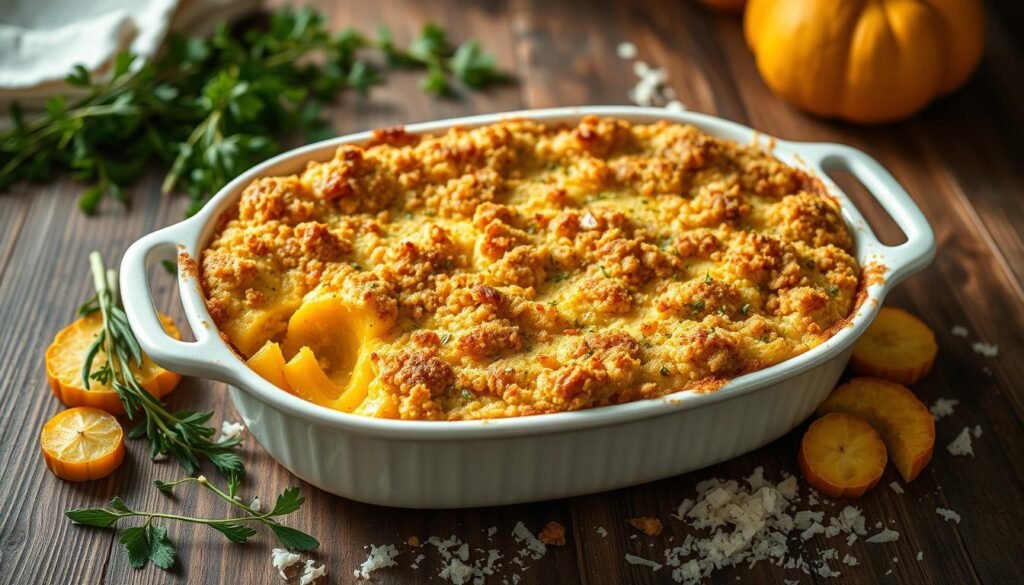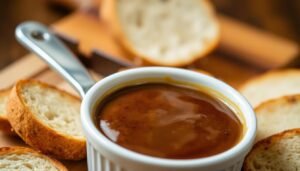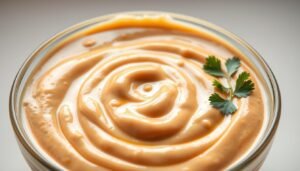As fall comes, we all think of warm, comforting dishes to share. The squash casserole recipe is a favorite among many. It’s a dish that everyone loves.
I’ve always loved this dish and I’m excited to share my Delicious Squash Casserole Recipe with you. It’s not only tasty but also easy to prepare. It’s great for any time, whether it’s a busy weeknight or a special event.
Key Takeaways
- A simple and delicious squash casserole recipe to try this fall.
- Tips for making the perfect squash casserole every time.
- Variations to the recipe to suit different tastes and dietary needs.
- How to make this dish a centerpiece for your holiday gatherings.
- Pairing suggestions to complement your squash casserole.
Introduction to Squash Casserole
A well-made squash casserole has a special power to bring families together. It’s a favorite in many American homes, more so in fall and winter. This is when squash is at its best.
What is Squash Casserole?
Squash casserole is a comforting dish made with squash and other ingredients like onions, garlic, cheese, and breadcrumbs. It’s easy to make and can be customized to fit different tastes and diets.
https://www.youtube.com/watch?v=zuJNrtPw998
The dish is loved for its simple yet rich flavors. It’s both healthy and tasty, making it ideal for family meals and holidays.
Nutritional Benefits of Squash
Squash is packed with nutrients that are good for you. It’s full of vitamins A and C, potassium, and fiber. The antioxidants in squash can help fight chronic diseases like heart disease and some cancers.
- Rich in Antioxidants: Squash has antioxidants that fight free radicals, lowering the risk of chronic diseases.
- High in Fiber: Squash’s fiber helps with digestion and can help with weight management.
- Good Source of Vitamins: It’s rich in vitamins A and C, important for a strong immune system and overall health.
Why You’ll Love This Recipe
This squash casserole recipe is not only tasty but also simple to make. It’s a great way to eat more veggies and is comforting for any meal.
The recipe can be customized with your favorite ingredients or seasonings. It’s perfect for family dinners or holiday meals, and everyone will love it.
Ingredients for Your Squash Casserole
A great squash casserole starts with the right ingredients. You need to pick the best parts to make it tasty and filling. We’ll look at the key ingredients and the benefits of fresh versus frozen squash.
Fresh vs. Frozen Squash
Choosing between fresh or frozen squash is your first decision. Fresh squash tastes richer and feels better in your mouth. But, it takes more time to prepare. Frozen squash, on the other hand, is quicker because it’s already cooked and mashed. You can pick either, based on what you like and how much time you have.
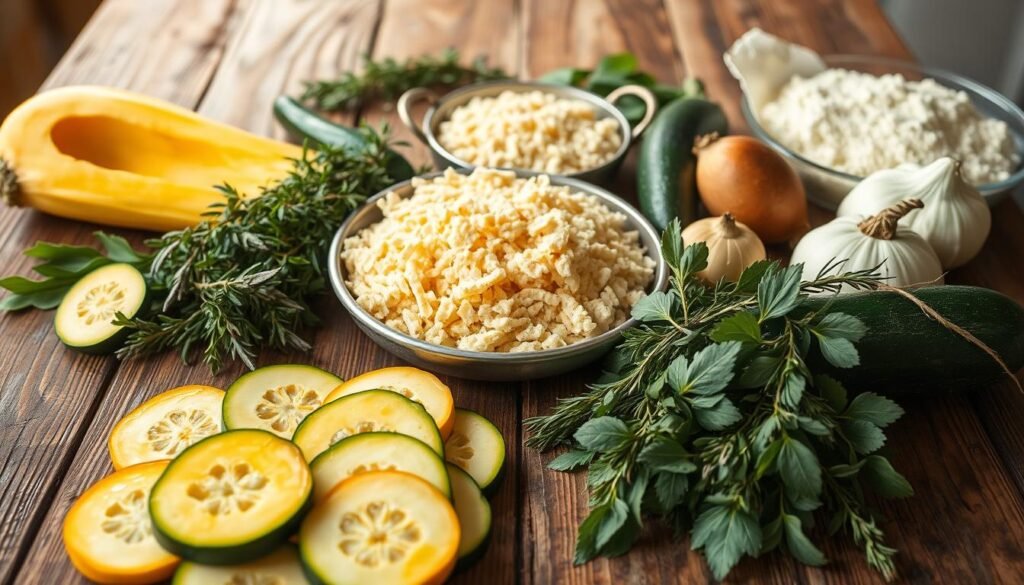
Essential Ingredients
The main ingredients for a classic squash casserole are:
- Squash (fresh or frozen)
- Onion
- Garlic
- Butter or margarine
- Eggs
- Cheese (such as cheddar or American)
- Bread crumbs or crushed crackers
- Seasonings (salt, pepper, and your choice of herbs)
These ingredients mix to make a creamy, cheesy dish. For a detailed recipe, check out this link.
Optional Add-Ins for Flavor
To add more flavor to your squash casserole, try these optional ingredients:
- Diced ham or bacon for a smoky taste
- Chopped fresh herbs like parsley or thyme
- A sprinkle of paprika for added depth
- Other cheeses like Parmesan or feta for a unique twist
Don’t be afraid to try these add-ins to make your casserole your own.
Preparing the Squash
The secret to a delicious squash casserole is in how you prepare the squash. Doing it right boosts the flavor and texture. It makes the dish a hit with everyone.
How to Select the Best Squash
Choosing the right squash is crucial. Look for one that’s firm and heavy, with no soft spots or mold. A good squash has a hard, smooth rind. For butternut squash, check that the stem is dry and the skin is even beige.
Tip: If you’re not sure what squash to pick, butternut squash is great for casseroles. It has a sweet, nutty taste.
Slicing and Prepping Tips
After picking your squash, it’s time to slice and prep it. Peel the squash with a vegetable peeler. Cut it in half lengthwise and scoop out the seeds. For butternut squash, use a spoon to remove the seeds and pulp.
Cut the squash into uniform pieces, about 1/2 inch thick. This ensures even cooking. You can roast the squash first or cook it directly in the casserole. For a roasted flavor, try roasting it as in this roasted butternut squash recipe, then add it to your casserole.
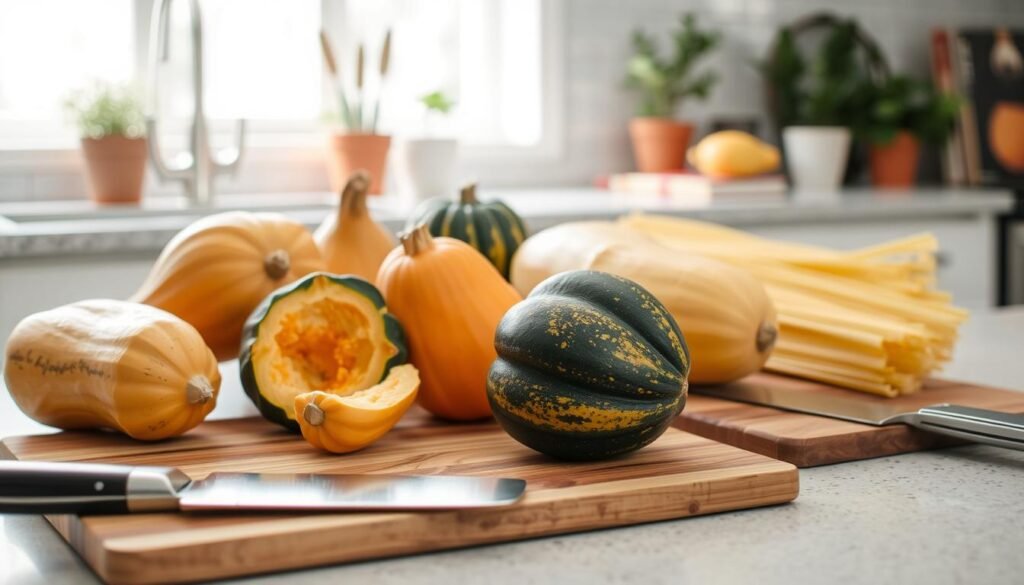
As “The best way to get started is to quit talking and begin doing.” This quote fits perfectly with squash preparation. It’s all about taking action and getting the job done efficiently.
Making the Casserole Base
Making the casserole base is where the magic begins. It’s crucial as it sets the tone for the entire dish. It combines flavors and textures that make your casserole stand out.
Prepping the Cooking Dish
Before mixing your ingredients, prep your cooking dish. Use a 9×13 inch baking dish, which is perfect for this recipe. Ensure it’s clean and dry before you start. You can lightly grease it with butter or cooking spray to prevent sticking.
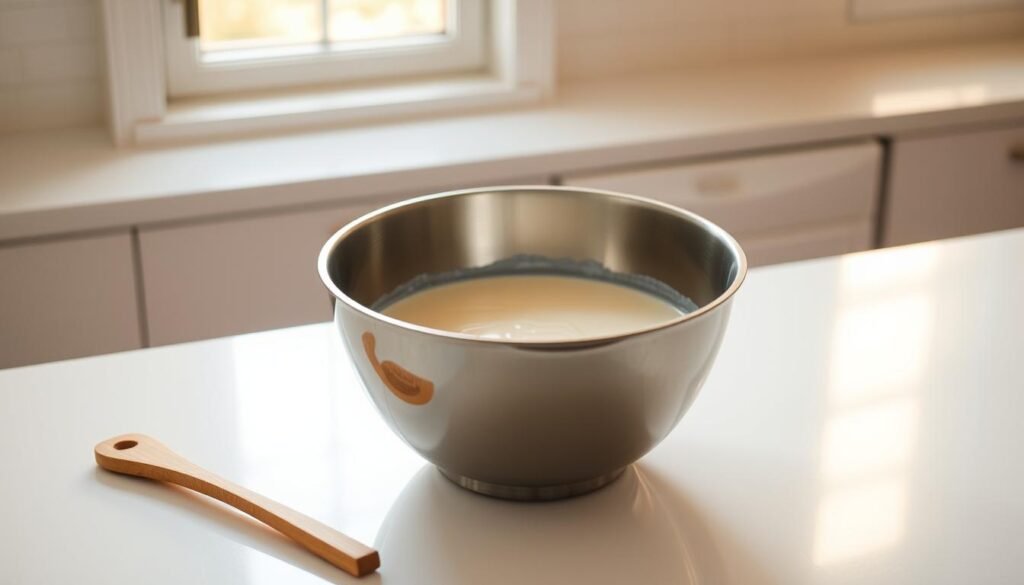
Mixing Ingredients Together
Mixing the ingredients is an art that requires finesse. Start by combining cooked squash, sautéed onions, and garlic in a large bowl. Then, add cream of mushroom soup, sour cream, and shredded cheddar cheese. Mix everything together until you achieve a smooth, consistent mixture. Be gentle to avoid breaking down the squash too much.
- Add the cooked squash and sautéed onions to the mixing bowl.
- Incorporate the cream of mushroom soup and sour cream.
- Mix in the shredded cheddar cheese until well combined.
Importance of Texture and Consistency
Achieving the right texture and consistency is vital for a great casserole base. You want it creamy but not too runny, and thick but still moist. The key is balancing the wet and dry ingredients. If you’re concerned about the consistency, you can adjust by adding more sour cream or cheese.
“The secret to a great casserole is in the balance of its components. Too much of any one ingredient can throw off the entire dish.”
By paying attention to the texture and consistency, you’ll end up with a casserole base that’s both flavorful and appealing.
Adding Flavor and Seasoning
To make your squash casserole amazing, learning about flavor and seasoning is key. The right mix can turn a simple side dish into a true masterpiece.
Herbs and Spices That Complement Squash
Squash tastes sweet, which goes well with many herbs and spices. Sage, thyme, and garlic are great choices. They boost the flavor and add to squash’s health benefits.
Want a little spice? Try cayenne pepper or red pepper flakes for a kick. A sprinkle of paprika brings a smoky flavor. Playing with herbs and spices lets you customize the taste.
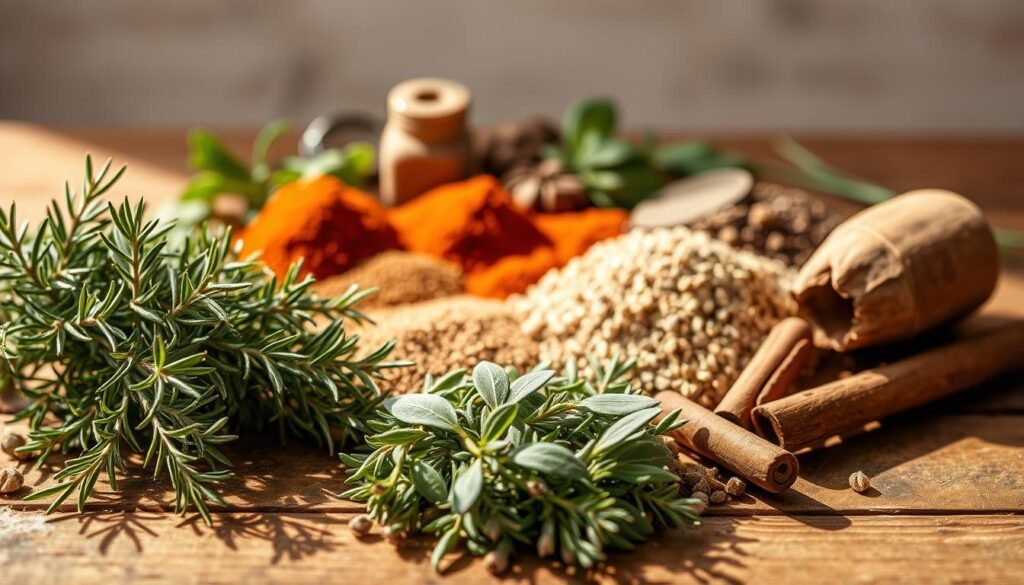
Cheese Options for Extra Creaminess
Cheese makes the squash casserole creamy and rich. Cheddar is a favorite for its sharp, tangy taste that matches squash’s sweetness.
For creamier texture, add Parmesan or Gruyère. These cheeses add depth and richness. A sprinkle of Gruyère on top before baking makes a golden, bubbly crust.
When mixing cheese with herbs and spices, the options are endless. The trick is to find a balance so no flavor dominates. This way, your squash casserole will be both tasty and unforgettable.
Baking the Squash Casserole
To finish our squash casserole recipe, we need to bake it at the right temperature for the right time. This step is key. It brings all the flavors together and gives the casserole its signature texture.
Recommended Baking Temperature
The best baking temperature for our squash casserole is 375°F (190°C). This temperature makes the squash tender and the top golden brown. Preheating the oven to this temperature is crucial for an even bake.
Cook Time for Perfectly Tender Squash
The cook time varies based on the casserole dish size and squash slice thickness. Generally, it takes about 35-40 minutes for the squash to be tender and the top golden brown. Here are some tips to check for doneness:
- Check the squash for tenderness by inserting a fork; it should slide in easily.
- Look for a golden-brown top, which indicates that the casserole is done.
- If the top is browning too quickly, cover the dish with foil to prevent overbrowning.
For a more detailed recipe and variations, you can visit Savory Experiments’ Cheesy Squash Casserole Recipe, which offers additional insights and tips.
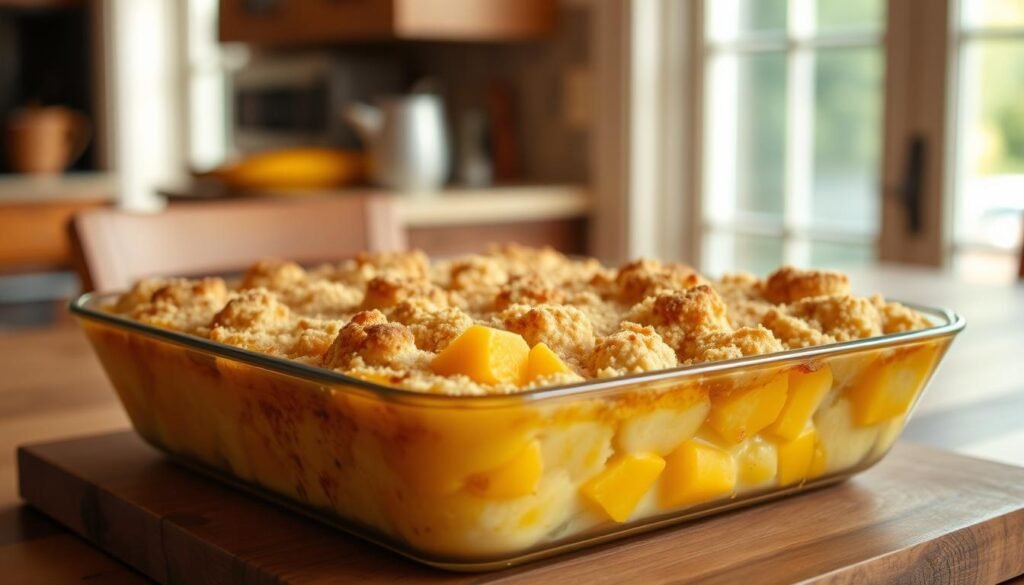
By following these guidelines, you’ll be able to achieve a perfectly baked squash casserole. It’s sure to impress your family and friends. Happy baking!
Serving Suggestions
Perfectly serving your squash casserole can make it even more enjoyable. Whether it’s for a family dinner or a casual get-together, there are many ways to impress. Your squash casserole can be the star of the show.
What to Serve with Squash Casserole
Squash casserole goes well with many main dishes. Here are some great options:
- Roasted chicken or turkey
- Grilled steak or pork chops
- Baked ham or sausages
- Vegetarian options like lentil soup or a fresh salad
For more pairing ideas, check out this table:
| Main Course | Recommended Side | Occasion |
|---|---|---|
| Roasted Chicken | Mashed Potatoes | Family Dinner |
| Grilled Steak | Roasted Vegetables | Special Occasion |
| Baked Ham | Scalloped Potatoes | Holiday Gathering |
How to Store Leftovers
Properly storing leftovers means you can enjoy your squash casserole for days. Here’s how:
- Cool the casserole completely before refrigerating or freezing.
- Use airtight containers for up to 3 days in the fridge.
- Freeze portions for up to 2 months. Reheat in the oven or microwave.
By using these tips, you can enjoy your squash casserole with family and friends for days.
Variations on Squash Casserole
Squash casserole is very flexible, making it fun to try new things. You can make it healthier or just mix it up. There are lots of ways to do it.
Healthier Alternatives
Want to eat less? Try using less cheese or a low-fat version. You can also add more vegetables like bell peppers or zucchini. This makes it healthier without adding too many calories.
Need a gluten-free option? Make sure your breadcrumbs or cracker crumbs are gluten-free. You can also use different squashes like acorn squash or butternut squash for different tastes and textures.
Creative Twist Ideas to Try
Want to get creative? There are many ways to change up squash casserole. Try adding crushed crackers or chopped nuts on top for crunch. Or mix in cooked bacon or sausage for a smoky taste.
For a vegan version, use a dairy-free cheese and a flax egg to hold it together. See more ideas on our cheesy squash casserole recipe page.
Trying these variations can make squash casserole exciting and versatile. It’s perfect for any time.
Conclusion
Now that you’ve reached the end of this guide, it’s time to enjoy your squash casserole. Making this dish is simple, and you’ll love the flavors of fall soon.
Recap of the Process
To make this tasty squash casserole, start by prepping your ingredients. Then, mix the casserole base and add your favorite flavors. Bake it until it’s perfect. This guide makes it easy for anyone to make this delicious dish.
Sharing the Dish
The best part is enjoying and sharing your squash casserole. Share it with family and friends, and it will become a favorite at gatherings. Cooking is about making memories with the people you love.

